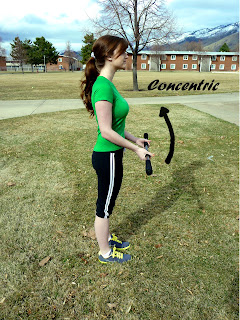Strength Training: What You Need to Know
To the females
reading this post: don't fall into the trap of thinking that strength training
is only for guys. Strength training is a great way to burn calories and to tone
your muscles. You can lift weights without turning into the
"She-Hulk"
Benefits of Strength Training:
- Increased performance of everyday physical tasks
- Higher levels of sport performance
- Injury prevention
- Increased muscle mass and decreased fat
- Improved muscle and bone health with aging
- Prevention and management of cardiovascular disease and diabetes
Types of Muscle Contractions:
- Concentric contractions- the muscle shortens as it contracts
- Ex: Pushing a bench-press bar away from your body shortens your pec muscles
- Eccentric contractions- the muscle lengthens as it contracts
- Ex: Lowering bench-press bar toward your body lengthens your pec muscles
- Isometric contractions- the muscle contracts but there is no movement or change in muscle length
- Ex: Holding a bench-press bar away from your body without moving for a certain length of time
Which Type of Contraction Should You Focus On?
- The type of contraction that burns the most calories is concentric muscle contraction
- The type of contraction that results in the greatest increases in muscle size is eccentric muscle contraction
- Isometric contractions will only increase your strength within 10 degrees from the angle in which you performed the exercise
Weight Machines or Free Weights?
- Weight machines are easy to use, convenient, and safe. You don't need a spotter and many will have back support.
- Free weights strengthen your body in ways that will be more useful in real life, are inexpensive, and are convenient for home use. They require more balance and coordination.
How Often?
- The American College of Sports Medicine (ACSM) recommends performing strength training on two nonconsecutive days per week
- Make sure that you give your muscles at least one day of rest between strength workouts. If you don't, your muscles won't have completely recovered and you won't be able to perform at the level you need to get any strength increases. You will be more likely to have increased soreness and increased risk of injury.
How Much Weight?
- Choose a weight that is heavy enough to tire your muscles, but light enough that you can complete your repetitions.
- For faster increases in strength, use weights that are as heavy as 80% of your maximum capacity.
- For increases in endurance, use weights that are around 40-60% of your maximum capacity.
- You can also choose a weight depending on the number of repetitions you can perform with a given weight.
How Many Repetitions?
- You need to perform enough repetitions to fatigue your muscles
- A heavy weight and a low number of repetitions, such as 1-5, will build high strength and high muscle mass.
- A light weight and a high number of repetitions, such as 15-20, will build endurance. This is the method I use, because I am more interested in toning than in getting large muscles.
How Many Sets?
- Performing 3 sets will give you the best increases in performance
- Make sure you give your muscles adequate rest between sets
Other Tips
- Whenever you do an exercise that moves a joint in one direction, make sure to also perform an exercise that moves the joint in the other direction.
- Perform exercise for large muscle groups before you do exercises for small muscle groups. This will allow you to maximally work out your large muscle groups.
- Warm-up before weight training by walking or jogging for several minutes
References
Fahey,
T. D., Insel, P. M., & Roth, W. T. (2010). Fit & well alternate edition: Core concepts and labs in
physical fitness and wellness. (9 ed., pp. 91-106). New York: McGraw-Hill.
Kenney, W. L.,
Wilmore, J., & Costill, D. (2011).
Physiology of sport and exercise. (5 ed.). Champaign: Human
Kinetics.





Thanks for that. Now I just need to figure out how to get my fat mass off the couch.
ReplyDelete